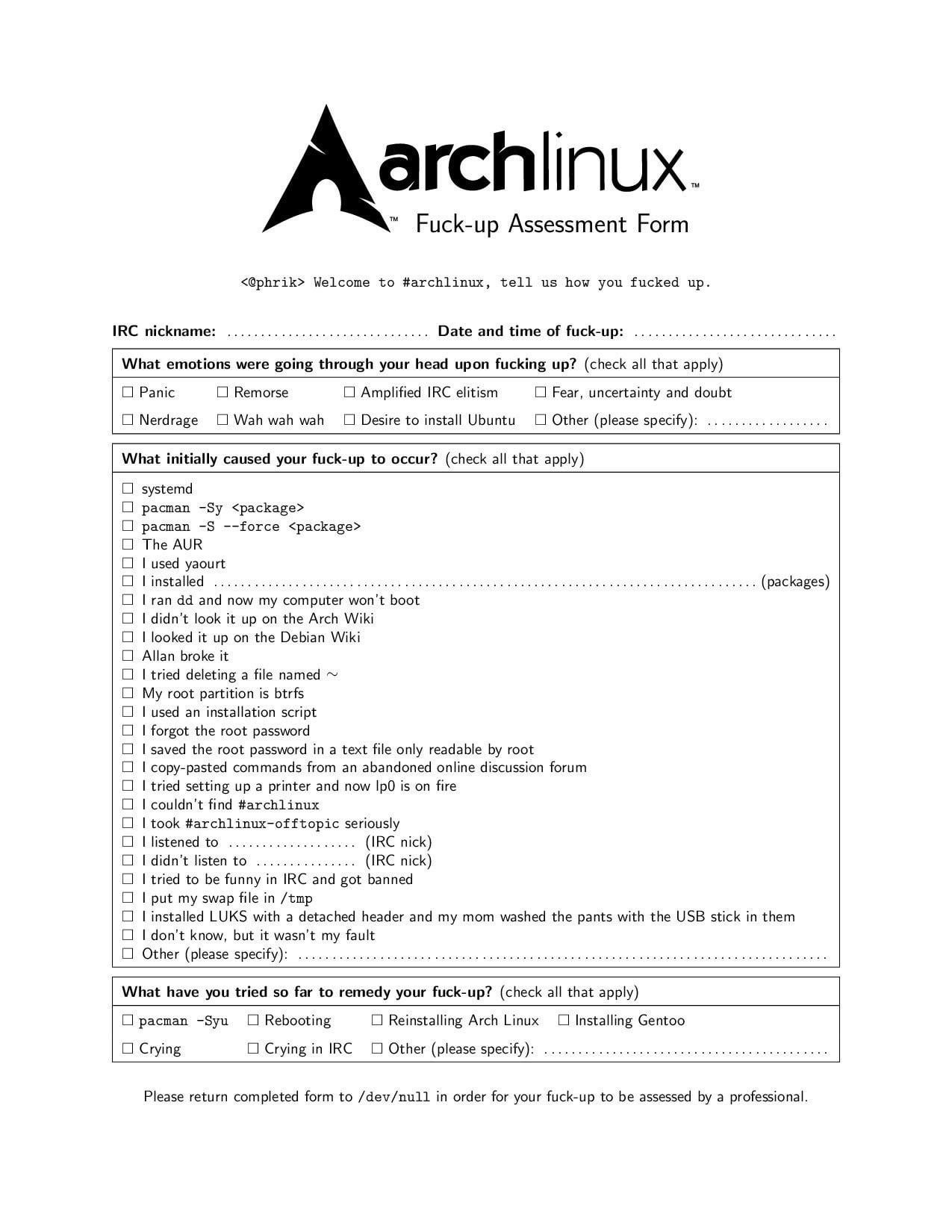Please return completed form to /dev/null in order for your fuck-up to be assessed by a professional.
Lol
For a second I thought that the first field was:
IRL nickname: I don’t use IRL
Nobody should use IRL, it sucks and is way too humid.
Floridean detected
What’s wrong with btrfs?
This is a rather old form and in its early days btrfs was not very stable.
My only gripe with btrfs is that I’ve had systems come down from a single drive failure in raid quite “often” when compared to other FS.
ZFS is a ram hog but I always could do a live resilvering without downtime.
btrfs’s RAID features are not production-ready, and at this point I doubt they ever will be. See:
https://en.wikipedia.org/wiki/Btrfs#Implemented_but_not_recommended_for_production_use
https://wiki.archlinux.org/title/Btrfs
https://www.phoronix.com/news/Btrfs-Warning-RAID5-RAID6
ZFS is definitely more robust.
It is true for raid 5 & 6. Raid 0, 1, and 10 are supposed to be production ready. I use raid 10 only with btrfs, anything else and I use zfs or mdadm.
People don’t know how CoW FSes work 🤷.
Nothing these days
performance
opening programs was noticeably slower for me
benchmarks confirm this, and I think this is an aspect not discussed often enough
I benchmarked it and it blew XFS out of the water
h–how did you manage that
Fucking Allan, always fucking shit up.
😬
All we wanted was some detail.
I liked using Arch, but i got tired of Allan breaking into my house and bricking my computers all the time, so i ended up switching
- lol
- My rootfs has been btrfs up to 2 days ago, when I switched back to TKFS (The King File System, AKA ext4) because I realized I have no use for the features of BTRFS.
What is the problem with using BTRFS for rootfs?
I think that this form is actually old, from when BTRFS was quite unstable. That point on the list made me chuckle.
It tends to break when you force power off the machine in my experience, where ext4 is super resilient to that kind of stuff.
Thats my experience at least.
Ext4 can’t detect data corruption while btrfs can. Btrfs has only bee stable for a handful of years now. It had way to many early adopters that were burned
Pacman -Syyu when you’re feeling extra desperate XD
That’s funny and sadly accurate 🤣
Can we make it real?
I asked for the source, we’ll see if we get it 😁.

Thank you kind stranger 😊.
Found a pdf: https://heinicke.xyz/nixos/alfa.pdf
Ah, this is even better, I could actually edit it as vector 😊.
I get the feeling. I had a fuck-up directory with solutions for my failed android rooting efforts. I tried to flash my phone with a random recovery image I found in an old FAQ section.
I’ve been trying to decide what distro I want to go with for my desktop (Microsoft recently pushed copilot onto my windows 10). While I like the idea of Arch (fast, lightweight) and the fact that it’d be fully compatible with whatever I get on my steam deck, stuff like this makes me think a Debian-based distro would be better.
(That and the fact that most Linux stuff is designed for Debian and I don’t have enough experience to try and rebuild Debian stuff for Arch)
The Deck is configured by Valve in a way uniquely suited to it, and they also make sure it works properly. It’s not going to be the same on vanilla Arch installed by you on your own PC.
Common wisdom for a beginner is to use something like Debian or Debian-based like Mint or Ubuntu because they’re popular and stable so you can get a safe start. I wouldn’t recommend Arch or Arch-based to a complete beginner.
Linux Mint
Debian is nice.
Wait until you need to validate the installed state of files on the machine. You’ll reconsider Debian like many security people do.
Wait until you need to validate the installed state of files on the machine.
I don’t think I’ve ever had to do that in all my years of using Debian. What does it even mean?
The aur usually has what I need, only have had to manually build once… Before I found the aur package. Endeavoros is a good easy way to get into arch if you are worried about the manual configuration.
Alright, cool. Why not Manjaro? I did a quick Google search and saw people saying Manjaro is bloated in comparison to EndevorOS, are there other reasons as well?
Yeah, they like forgot to reupload a new cert 3 times.
And they hold packages back. EndeavourOS uses Arch’s repos directly, whereas Manjaro has it’s own repos. EndeavourOS is just Arch with a GUI installer and some handy prepicked choices, like a DE.
Yeah, they like forgot to reupload a new cert 3 times.
It happens to everybody, including Microsoft, Google, Amazon etc.
Actually, most of them have automatic cert renewal… in fact, most web services have that nowadays.
DNS at any company tends to be a mess. Multiply that by a thousand for a large multinational corporation. Case in point, here’s Microsoft (and these are never going to stop, due to the sheer complexity):
- https://www.theregister.com/2024/06/28/microsoft_security_certificate_expires/
- https://www.theregister.com/2024/07/08/microsoft_swiftkeys_cert_expires/
- https://www.theregister.com/2023/05/24/microsoft_surface_pro_x_cameras/
- https://www.theregister.com/2022/06/10/microsoft_insider_certificate/
Even when you use an automated service things can go wrong. For example I use Let’s Encrypt but it needs to verify my DNS ownership so I use an API token to let the certbot make the modifications to prove that. At some point I wanted to restrict the token rights so it only has access to certain TXT records (to increase security in case the token every gets compromised). Long story short I forgot to include one wildcard and that particular certificate couldn’t get renewed so it was out for the day until I fixed it.
Manjaro’s website is made for presentation purposes and whether it’s up or not has no impact on how the distro runs or whether you can download packages. Furthermore it’s a completely different team from the distro developers so this has no bearing on the package quality. I’ve been a Manjaro user when some of the manjaro.org certificates expired but I never knew about it because it didn’t affect me in any way.
manjaro.org uses Let’s Encrypt now and it’s been recently redesigned.
There are three distros derived from Arch that try to do very different things:
- Endeavour is Arch with a friendly installer. That’s it. It will install faster but then you’ll be using Arch, and that’s not a good idea for a beginner.
- Garuda is also Arch but with a few more helpful tools and apps. Same reasoning as above.
- Manjaro uses Arch packages as an upstream source (like Ubuntu vs Debian) but does things to them to make it stable. Which, unfortunately, makes a certain kind of Arch fan foam at the mouth and you’ve probably already been linked to “manjarno” and similar idiocy. So you’d have to deal with that.
But seriously, I have mixed feelings recommending Manjaro to a beginner. The distro itself is super-stable and easy to use because you basically have to do nothing. I have non-computer savvy family members on Manjaro without admin privileges and it works perfectly.
But the trick is that doing nothing part. You have to leave it alone and not modify the way it works, and beginners often feel the need to tinker with the system… Not only that but it’s hard as a beginner to figure out online what’s generic Arch advice and what’s Manjaro-specific and which of that can be applied safely on Manjaro and which is an Arch-ism that will ruin your install.
If you’re set on trying Manjaro I can offer a list of recommendations to give you an idea of how to navigate the dos and donts.
Just ignore “bloat” on principle. It’s a meaningless term and leads to much suffering.
Untold numbers of systems have been made unbootable, untold years of time wasted, trying to get rid of “bloat”.The most “bloated” distro in the world is probably a default Slackware installation.
It installs every single package in its repo. Including several desktop environments and every single KDE program.
And it’s just 2/3 of the size of a Windows installation.

















